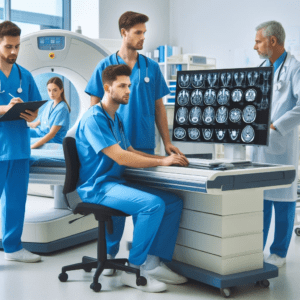The Diploma in Radiology and Imaging Technology program is designed to equip individuals with the specialized knowledge, technical skills, and clinical experience required to operate imaging equipment and perform diagnostic procedures in radiology departments, hospitals, imaging centers, and other healthcare settings. Radiology imaging technologists play a critical role in the diagnosis and treatment of various medical conditions by producing high-quality medical images that help healthcare providers identify diseases, injuries, and abnormalities. This diploma program prepares students for entry-level positions in the field of radiologic technology.
- Radiologic Physics:
Students learn the principles of radiologic physics, including the properties of radiation, interactions of radiation with matter, and factors affecting image formation. They gain an understanding of X-ray production, X-ray tube components, X-ray beam characteristics, and radiation safety principles. - Radiographic Anatomy and Positioning:
This segment focuses on teaching students the anatomy of the human body as it appears on radiographic images. Students learn to identify anatomical structures, understand their spatial relationships, and visualize their appearances in different radiographic projections and positions. - Radiographic Techniques:
Students learn a variety of radiographic techniques used to produce diagnostic images of different body parts and systems. They study techniques such as general radiography, fluoroscopy, computed tomography (CT), magnetic resonance imaging (MRI), mammography, and interventional radiography. - Radiographic Equipment Operation:
Students are trained in the operation of radiographic equipment, including X-ray machines, fluoroscopy units, CT scanners, MRI machines, mammography units, and other imaging modalities. They learn to set exposure parameters, position patients, and produce high-quality diagnostic images. - Patient Care and Management:
Students learn to provide patient care services in radiology departments, including patient assessment, positioning, immobilization, and comfort measures. They develop communication skills to interact with patients, explain procedures, address patient concerns, and ensure patient safety and confidentiality. - Radiation Protection and Safety:
Students study radiation protection principles, regulations, and safety practices to minimize radiation exposure to patients, healthcare workers, and the public. They learn about radiation biology, dose monitoring, shielding techniques, and radiation risk management strategies.
Image Processing and Analysis:
Students learn to process and analyze radiographic images using digital imaging technology and picture archiving and communication systems (PACS). They gain skills in image enhancement, manipulation, measurement, and interpretation to assist radiologists in image diagnosis.- Quality Control and Assurance:
Students learn about quality control measures and quality assurance programs in radiology departments. They study techniques for evaluating image quality, troubleshooting equipment malfunctions, and ensuring compliance with regulatory standards and accreditation requirements. - Ethical and Legal Considerations:
Students study ethical principles, legal regulations, and professional standards governing the practice of radiologic technology. They learn about patient rights, informed consent, confidentiality, documentation practices, and professional conduct in radiology practice. - Clinical Practicum:
Hands-on clinical experience is an integral part of the curriculum, allowing students to apply theoretical knowledge and develop practical skills in real-world radiology settings. Clinical rotations take place in radiology departments, hospitals, imaging centers, and outpatient clinics under the supervision of experienced radiologic technologists and radiologists.
- Radiologic Technologist:
Operating radiographic equipment, performing diagnostic imaging procedures, positioning patients, and producing high-quality medical images for interpretation by radiologists and other healthcare providers. - CT Technologist:
Operating CT scanners, preparing patients for CT scans, administering contrast agents, and producing cross-sectional images of internal organs and structures for diagnostic purposes. - MRI Technologist:
Operating MRI machines, positioning patients for MRI scans, administering contrast agents, and producing detailed images of soft tissues, organs, and anatomical structures using magnetic resonance imaging technology. - Mammography Technologist:
Performing mammography exams, positioning patients for breast imaging, operating mammography equipment, and producing mammographic images for the detection of breast cancer and other breast abnormalities. - Interventional Radiologic Technologist:
Assisting radiologists in interventional radiology procedures, such as angiography, fluoroscopy-guided interventions, image-guided biopsies, and vascular interventions, to diagnose and treat diseases. - Radiology Department Supervisor:
Assuming leadership roles in radiology departments, supervising radiologic technologists, managing workflow, coordinating patient scheduling, and ensuring the quality and efficiency of radiology services.
The Diploma in Radiology Imaging Technology program prepares students for dynamic and rewarding careers in radiologic technology. By mastering the principles of radiologic science, developing technical skills, and gaining clinical experience, graduates contribute to the diagnosis and treatment of diseases, promote patient safety, and uphold ethical standards in radiology practice, advancing the quality of healthcare delivery and patient outcomes.
